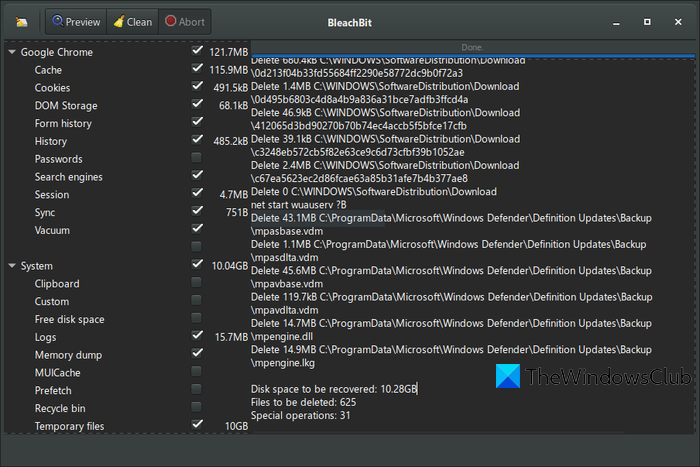BleachBit is a free and open-source, cross-platform system cleaner that is designed to clear disk space as well as wipe free space of a computer. BleachBit can delete temporary files, cookies, history, saved passwords, and many other things from your Windows computer. It supports many applications including the most popular ones like Adobe Reader, Mozilla Firefox, Google Chrome, Internet Explorer, File Zilla, Team Viewer, VLC Media Player, etc. BleachBit comes with an inbuilt file shredding utility that can permanently delete files, which can’t be recovered in any way.
BleachBit for Windows PC

BleachBit automatically loads apps installed on your system. If you want support for more programs—over 1200—you can add it via an optional winapp2.ini file. Many applications are supported, but in this post, I am going to discuss only some of them, mostly the common ones or the system applications.
It can permanently delete or shred files and rewrite free disk space. It also offers a command-line interface.
Let us check out its features.
Deep Scan: It lets you delete the old and temporary backup files to clear some disk space on your computer. Moreover, it can also delete Thumbs.db and .DS_Store files can consume too much disk space if not cleared frequently. Deep Scan is a slow process as the name only suggests, it is going to deeply scan your computer for any temporary files or junk files.
System: The System section itself has many features, they are:
- ClipBoard: Clears and cleans the Clipboard
- Custom: It is used to clear any of the user-specified files or folders. You can select files and folders to be deleted from the Preferences Window.
- Free Disk Space: Overwrites free disk space to hide the deleted files.
- Logs: Deletes all the log files generated.
- Dump: It deletes the file Memory.Dump
- MUICache: This feature is very useful as it can be used to clear the cache files.
- Recycle Bin: Completely deletes files from Recycle Bin.
- Temporary Files: Delete all the unwanted temporary files from the system.
- Uninstallers: Indeed a useful function, deletes the uninstallers for Microsoft Updates and Internet Explorer Updates.
Windows Explorer: BleachBit can be used to clear Windows Explorer’s recently used lists, thumbnail caches and search history.
Microsoft Office: For Microsoft, Office BleachBit can clear debug logs and recently used lists.
Silverlight: BleachBit can clear Silverlight cookies that are mostly used to store website preferences, tracking identification, etc.
There are many other applications supported that you must notice while using the program. Before hitting the clean button, you must click the ‘Preview’ button in order to perform a scan and check the number of files that can be deleted and their file size.
The File Shredder is amazing too as it lets you delete the files permanently so that no one will be able to recover them using a file recovery software. Overall the software is must-have; it comes with great features that are worth the use.
This free junk file cleaner also includes a Self Cleaning feature that lets you shred its own settings. This is found in the File menu. Looking at these features, it sure looks that this free open-source software takes your privacy seriously.
BleachBit is available in both portable as well as an installer version. Click here to download BleachBit.
Related reads:
It appears Schneier initiated the “trust list” of products he used, including TrueCrypt and Bleachbit, in a September 06, 2013 “The Guardian” piece titled “NSA surveillance: A guide to staying secure”, but within a context that open source products are usually presumably less susceptible to coercions to insert backdoors or “forget-to-run” code…not that anything on his list is de facto perfect in default-setting operation.
Many blogs and review sites describe BleachBit as originating as a CCleaner for Linux, and since becoming cross-platform keep equating its non-self cleaning capabilities to CCleaner without additives of “CCEnhancer”; as for what BleachBit itself claims at its own site re inability of anyone to recover data after just one layer of its erasure scrambling, note currently BleachBit underscores that FAQ with a date in 2010…four years old, four years prior to Passware inter alia ability to recover TrueCrypt keys from a container hiding in randomized data (such as cleaners overwrite spaces with).
But you’re quite correct BleachBit at least can get rid of its own settings, unlike most other cleaners; where this is a concern for users, there being differences in algorithmic dynamics between spinning HDDs and static SSDs, a user should run something like “Recuva” after using BleachBit and ensure nothing like cluster tips can be recovered from overwritten space…if anything still shows up, a competent utility for then overwriting free space and resetting all sectors to “zero” should be used. It’s possible BleachBit may not overwrite some files at all, as its site at another security FAQ uses another years-old post comment saying it can’t overwrite compressed files but that’s not an issue because “NTFS disks are rare”…is that true anymore in Windows following XP? So someone getting rid of even zipped job search applications should verify efficacy of erasure to prevent personal data falling into hands of hackers or plain snoops/thieves…if you can see with Recuva, so can they.
Thanks for highlighting a cleaner which can actually clean after itself, and I hope my nittering caveats are somehow of use. Cheers!
I haven’t heard/tried about this Bleachbit before.